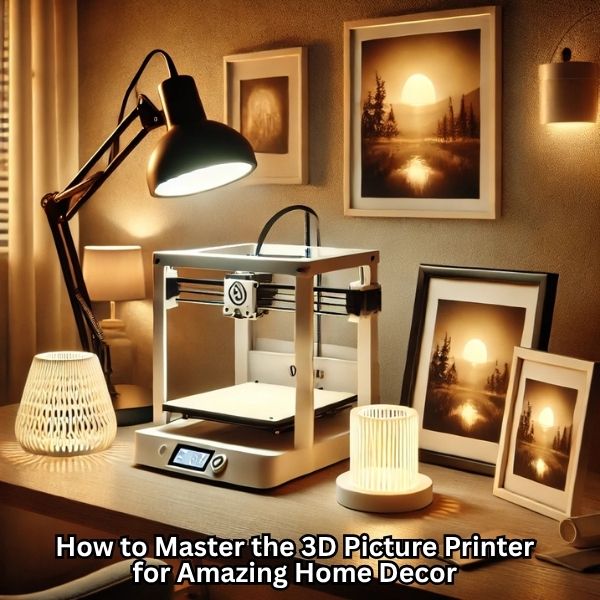How to Master the 3D Picture Printer for Amazing Home Decor

Turn Photos into Stunning Home Decor with a 3D Picture Printer
Picture your favorite photo—not in a dusty frame, but glowing softly on your wall. Not flat, but full of light, shadow, and texture. That’s what you can create with a 3D picture printer.
This technology allows you to bring your memories to life by converting regular photographs into eye-catching, touchable pieces of art. Whether you’re decorating a cozy apartment or looking to personalize a larger space, 3D-printed picture art offers a fresh way to make your walls speak for you. And if you’re planning to turn this creative idea into a source of income, investing in the best 3d printer for small businesses can help you produce high-quality prints efficiently and professionally.
This guide will walk you through everything you need to know to get started with a 3D picture printer—from choosing the right tools to printing your first image. If you’ve ever wanted home decor that tells a story, this is your chance to make it happen.
What Is a 3D Picture Printer and Why Use One?
A 3D picture printer is a type of 3D printer designed to create photorealistic lithophanes—translucent panels that reveal detailed images when backlit. These prints turn simple photographs into elegant, embossed artwork.
Instead of color, they rely on depth and light. Lighter areas in the photo are printed thinner, while darker areas are thicker, producing a highly detailed relief. When lit from behind, the image comes to life with contrast and texture.
Unlike traditional prints or digital frames, this method adds physical depth, giving the image a sculptural presence that changes with lighting and angle. This unique interplay between light and layers creates an emotional connection rarely achieved with flat decor.
Types of 3D Printers Suitable for Lithophanes
Not all 3D printers produce lithophanes equally. If you’re serious about quality, understanding the differences between printer types helps you get the best result.
FDM (Fused Deposition Modeling) Printers
FDM printers build models layer by layer using melted plastic. They’re affordable, accessible, and easy to work with—perfect for beginners. However, their resolution is lower than resin-based printers.
Best options:
- Creality Ender 3 V2 – Budget-friendly, reliable, and ideal for larger lithophanes.
- Prusa i3 MK3S+ – Excellent balance of quality, ease, and community support.
Resin (SLA/MSLA) Printers
Resin printers cure liquid resin with UV light. These offer incredibly fine detail, making them great for intricate lithophanes, though the work environment is a bit more demanding.
Top picks:
- Anycubic Photon Mono X – High resolution and fast printing.
- Elegoo Mars 3 – Affordable resin printer with solid detail quality.
Comparing FDM vs. Resin for Home Decor
| Feature | FDM Printers | Resin Printers |
| Print Quality | Moderate | High |
| Setup Difficulty | Easier | Slightly harder |
| Material Cost | Lower | Higher |
| Odor & Safety | Minimal | Needs ventilation |
| Best For | Large pieces, beginners | Detailed pieces, advanced users |
If you’re new and want to test the waters, FDM may be enough. But if fine detail and sharp shadows matter most to your final piece, resin printers offer a noticeable upgrade.
Step-by-Step: Creating Your First 3D Picture Print
You don’t need to be a tech wizard to make your own custom 3D lithophane. With a bit of patience and the right tools, anyone can do it. Here’s a complete process to follow.
1. Choose the Right Image
Start with a well-lit photo. High contrast images (light backgrounds, dark details) work best. Portraits, landscapes, and close-ups all translate well into the medium. If your photo is too dark or flat, try adjusting contrast and brightness before moving forward.
2. Convert Your Photo into a 3D Lithophane
Use a photo-to-lithophane converter software. Many free tools allow you to upload a photo and generate a 3D model in STL format. Choose options like flat, curved, or dome shapes depending on how you want to display the final product.
Settings to look for:
- Base thickness: 0.8 to 1.2 mm
- Image height: 3 to 5 mm
- Smoothing: On, if available
This model becomes the foundation for your 3D print.
3. Import to Slicer and Prepare for Printing
After converting your image to STL, load it into slicing software (e.g., Cura for FDM printers or Lychee for resin printers). Adjust the following:
- Layer height: 0.1 mm or less for better detail
- Infill: 100% for consistent light transmission
- Print orientation: Vertical is often best for lithophanes
- Supports: Optional depending on shape
Export your G-code (FDM) or sliced file (resin), and you’re ready to print.
4. Use the Right Material
White PLA or translucent resin is the go-to for lithophanes. They diffuse light evenly and make the image pop when backlit. Avoid colored filament, as it may reduce clarity.
5. Printing and Post-Processing
Once your printer is set, begin printing. FDM prints can take 4–8 hours depending on size; resin prints vary but are often faster for small items. After printing:
- Gently remove supports (if any)
- Clean resin prints with isopropyl alcohol
- Avoid sanding lithophanes as it can blur detail
Creative Ways to Display 3D Picture Prints
Once you’ve printed your lithophane, the fun part begins—turning it into decor that makes your home feel more like you.
Lithophane Nightlights
Mount your print onto a nightlight base. These are available online or can be made using simple electronics. Soft backlighting makes the image visible at night without being harsh on the eyes.
Framed Window Panels
Frame your lithophane and hang it near a window. Natural sunlight creates a glowing photo effect that changes with time of day.
Custom Lamp Shades
Replace the panels in an existing lamp with lithophanes, or 3D print a custom housing. Each time you turn on the light, your room will be bathed in shadows of your memory.
Rotating Display Bases
Some creative users install rotating bases with internal lights to give lithophanes a dynamic look. These make great centerpieces for living rooms or desks.
Holiday Ornaments and Gifts
Small, round lithophanes can become keepsake ornaments for the holidays. Add a ribbon loop, and they’re ready for the tree—or make them as gifts for loved ones.
Tips for Better Results (Learned from Trial and Error)
Even with a good printer, your results depend on how you prepare. Here are hard-earned lessons from the community and personal trials.
- Start small: Don’t waste filament on large pieces until you’ve dialed in your settings.
- Test your light source: Lithophanes need consistent backlighting to reveal detail. A poor light makes even a perfect print look dull.
- Avoid grainy images: If the source image is low-res or blurry, no printer can fix that.
- Use portrait orientation for slicing: This reduces visible layer lines and increases detail fidelity.
- Level your bed carefully: A small tilt can ruin a lithophane. Bed leveling matters more than ever.
Common Issues and How to Fix Them
My lithophane looks blurry or washed out
- Try increasing contrast in the original photo
- Use a higher-resolution image
- Ensure your layer height is 0.1 mm or less
The image isn’t showing when I shine light through it
- Use a stronger or more even light source
- Ensure the print was oriented correctly (thin areas should face the light)
- Check that your filament is light-colored or translucent
It’s warping or curling during printing
- Make sure your print bed is clean and leveled
- Use a brim or raft to improve adhesion
- Avoid drafts or temperature swings during the print
Frequently Asked Questions
Can I use a color photo?
Yes, but the color won’t appear in the print. Convert it to grayscale first to check how well it translates into light and dark areas.
How long do these prints last?
With proper care, lithophanes printed in PLA or resin can last years. Keep them out of direct heat or sunlight to prevent warping.
What’s the best size for lithophanes?
Anywhere from 60mm x 60mm to 150mm x 150mm works well for household use. Larger prints work better in frames or lamps.
Can I make one using my phone photo?
Absolutely. Just make sure it’s high-resolution. Even smartphone images can make stunning lithophanes if the lighting is good.
Is it safe to use resin-printed lithophanes indoors?
Yes, once cured, they’re safe. Just ensure proper ventilation during printing and curing.
Conclusion: A New Way to Celebrate Old Memories
Using a 3D picture printer is more than a fun hobby—it’s a way to bring your most treasured moments into your daily life. Every print tells a story, lights up a memory, or adds character to a room.
By combining light, depth, and personal imagery, these prints stand out in a world filled with mass-produced decorations. Whether you start with a nightlight or an entire wall of glowing memories, one thing is certain—your space will never look the same.



